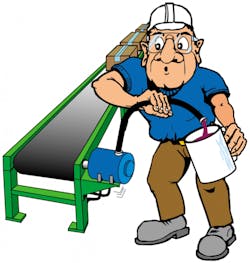Scenario: Ken, a millwright, suffered an eye injury, minor burns, bruises, and abrasions as a result of an accident he suffered while testing a hydraulic motor. Surprisingly, when the accident occurred he was following the test procedures that were included in the troubleshooting section of the machine manufacturer’s service manual.
Ken had received a report that a conveyor stopped unexpectedly and would not respond to the start/stop control switch on the operator’s console. During his initial examination of the equipment, he noticed that the operating temperature of the oil had risen from a normal of 110° F to approximately 170° F. He also noticed that oil was leaking from the shaft seal in the motor.
He then referred to the troubleshooting section in the machine manufacturer’s service manual for guidance. It stated that shaft-seal leakage is a symptom of excessive internal leakage, and gave general instructions on how to test for such leakage. Here are the recommendations given by the manufacturer to perform the test:
1. Disconnect the case drain line from the port at the motor housing.
2. Hold the open end of the drain line in a receptacle.
3. While holding the line, operate the machine through a load cycle.
4. If a small amount of oil exhausts from the line, the internal leakage is satisfactory, so only the shaft seal needs to be replaced.
5. If a large volume of oil exhausts from the line, leakage is excessive. The motor should be replaced.
Next, Ken locked out the machine in accordance with his company’s lockout policy and proceeded with the test. He first disconnected the hydraulic line that was connected to a port in the motor housing, but the case drain line was approximately 75 feet long, and not readily accessible, so he fabricated a (temporary) shorter length of hose and connected it to the motor. He placed the open end of the hose in an empty 5-gal oil container.
Now he was ready to perform the test, so he removed his lock from the breaker. Holding the hose in the neck of the container, he called the operator on his 2-way radio and asked him to run the machine through a load cycle. When the test commenced, the conveyor was unloaded.
As the motor began to turn, the millwright pulled the hose away from the neck of the container so he could see any leakage, Figure 1. A stream of oil began to exhaust from the hose, into the container. At first the leakage appeared to be minor. Then, without warning, the oil began to spray out of the hose with such intensity that it jerked the hose violently, tearing it out of his hand. It jerked back and forth rapidly; the oil struck him in the face, knocking his safety glasses off as the hose pulled away. As it twisted back the other way, it struck him against the chest, knocking him backwards and over the edge of the platform on which he was standing. He fell approximately 3 feet to the ground. The operator shut the machine off when he noticed the low-oil-level warning light flashing on the instrumentation console.
Ken was taken to a hospital and treated for minor burns and abrasions and had to have hydraulic fluid flushed from his eyes. He was thankful that he was wearing his safety glasses, because the oil exhausting from the hose hit his face with such brutal intensity that the rims of his safety glasses bruised the perimeter of his eye sockets.
What caused the flow to increase so dramatically?
First, you must remember two fundamental principles applicable to hydraulics. One, pressure is a function of resistance to flow. Two, the greater the pressure difference across an opening, the greater the flow rate.
When the test commenced, the conveyor was running unloaded, so the system pressure was relatively low. Thus, even if a motor was worn or damaged, the leakage could be minor. However, when the load was placed on the conveyor, the pressure immediately increased to meet the load demand. High-pressure differential can force a large volume of oil through excessive clearances caused by wear or damage.
This is precisely why testing any hydraulic component to atmosphere can cause severe injury, death, or substantial property damage — it should never be done!
How this accident could have been prevented
This motor test is probably one of the most simple, straightforward tests for hydraulic components. It can be executed with the highest degree of safety. Here is an outline of how a motor case flow test should be conducted:
1. Install a suitable flow meter in the case drain line, Figure 2.
2. Operate the machine (if possible) until the oil temperature is normal — approximately 130° F.
3. Operate the machine at no-load (nominal pressure), and record the no-load flow and pressure.
4. Operate the machine at full load (maximum pressure), and record the full-load flow and pressure.
5. Check the no-load flow against the full-load flow, and see that it is within recommended specifications. A good go/no-go rule-of-thumb is that if the full-load flow exceeds the no-load flow by approximately 25%, the leakage is excessive.
Note: using case flow tests exclusively to determine wear in hydraulic pumps and motors is not recommended. It does not detect wear between the barrel and the port/wear plate, and can therefore mask a significant amount of leakage that is not detectable in the case drain line.
Training — Training is the most significant vehicle for improving safety in all walks of life. As you will witness through this series of articles, ignorance is the root cause of almost all accidents associated with hydraulics. The fact that this test procedure was actually published in a service manual — and probably found its way into the hands of unsuspecting people (possibly all over the world) — is testimony to the fact that ignorance in the fluid power industry is far reaching.
Safety information — It was inevitable that someone following this procedure would get hurt. However, the recommendations neglected to mention additional crucial safety information which, although not directly related to the task at hand, should always be reinforced:
• lockout and tagout — critical
• safety glasses — critical
• proper diagnostic tools — critical
• proper skills — critical, and
• names of contacts for technical assistance — important.
Do not compromise — Machinery and equipment manufacturers sometimes assume that the customer will not have the proper tools to do the job. Consequently, they may offer a compromise. For example, remove a hose and “see” the flow, instead of using a flow meter. Or, crack a line to “see” for pressure, instead of using a pressure gage.
Manufacturers should state emphatically in their verbal and written communication, that if a person does not have the proper training and/or tools, they must not attempt to do the test. They should also point out the consequences of failing to follow safety recommendations.
Job safety breakdown — Machinery and equipment manufacturers should provide detailed Job safety breakdowns for the machinery they design and build.
Lead by example — Technical representatives from machinery or equipment manufacturers are extremely influential people. If they set a good example for safety in the field, others will follow. Not only must they abide by their own safety rules and procedures, but they must also respect those of their customers.
If they service a customer’s machine, they must have with them the proper diagnostic tools and equipment. If they are working with a customer’s personnel, they must continuously reinforce safety and tell what they are doing and why. The hard-working people in our plants and factories need all the help they can get — if you learn and know, share it with the world!
Technical schools and colleges— The greatest incubator for safety is where minds go to learn — the classroom. Fluid power instructors themselves must learn how to execute safe test procedures so they can help others do the same.
Stress safety every day and for each and every step taken in a job— and never give up! Demonstrate that you really care about safety, and you may save a few lives. What can be more important than that?
Rory McLaren is president, Fluid Power Training Institute, Salt Lake City. For more information, call (801) 908-5456, email [email protected], or visit www.fpti.org.
Caution: Rory McLaren and the Fluid Power Training Institute do everything possible to ensure that the information and drawings contained in these reports are accurate and that the suggested procedures are deemed safe and reliable. However, these are general recommendations only and might not be applicable to all situations. You must have your engineering and service departments read these recommendations and make the necessary changes for your specific conditions.The Fluid Power Training Institute is not responsible for actions taken by untrained or unauthorized persons. All hydraulic system service, repair, and troubleshooting should be conducted only by trained, authorized personnel.


